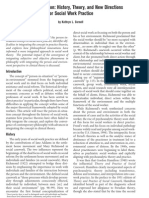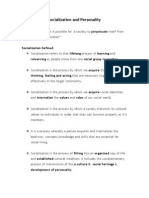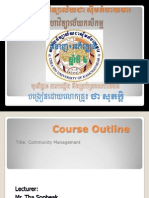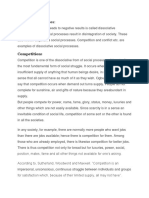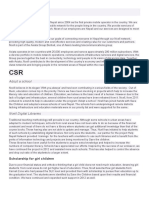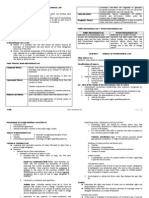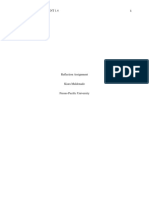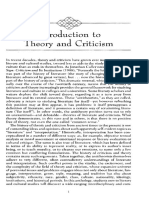100%(1)100% found this document useful (1 vote)
683 viewsSocial Change and Development
Social Change and Development
Uploaded by
Zeeshan AhmadSocial change occurs gradually as new behaviors are adopted by many members of a society. It is difficult to predict how or how quickly a society will change, as change depends on existing cultural norms. Key forces that lead to social change include technology, demographics, the environment, and revolution or war. Social change theories view it as a process of reaching a new equilibrium (functionalism) or the result of conflicts between groups over resources (conflict theory).
Copyright:
© All Rights Reserved
Social Change and Development
Social Change and Development
Uploaded by
Zeeshan Ahmad100%(1)100% found this document useful (1 vote)
683 views24 pagesSocial change occurs gradually as new behaviors are adopted by many members of a society. It is difficult to predict how or how quickly a society will change, as change depends on existing cultural norms. Key forces that lead to social change include technology, demographics, the environment, and revolution or war. Social change theories view it as a process of reaching a new equilibrium (functionalism) or the result of conflicts between groups over resources (conflict theory).
Original Description:
Social change and Development
Copyright
© © All Rights Reserved
Share this document
Did you find this document useful?
Is this content inappropriate?
Social change occurs gradually as new behaviors are adopted by many members of a society. It is difficult to predict how or how quickly a society will change, as change depends on existing cultural norms. Key forces that lead to social change include technology, demographics, the environment, and revolution or war. Social change theories view it as a process of reaching a new equilibrium (functionalism) or the result of conflicts between groups over resources (conflict theory).
Copyright:
© All Rights Reserved
100%(1)100% found this document useful (1 vote)
683 views24 pagesSocial Change and Development
Social Change and Development
Uploaded by
Zeeshan AhmadSocial change occurs gradually as new behaviors are adopted by many members of a society. It is difficult to predict how or how quickly a society will change, as change depends on existing cultural norms. Key forces that lead to social change include technology, demographics, the environment, and revolution or war. Social change theories view it as a process of reaching a new equilibrium (functionalism) or the result of conflicts between groups over resources (conflict theory).
Copyright:
© All Rights Reserved
You are on page 1of 24
Social Change
Social change occurs when many members of a
society adopt new behaviors that have long-term
and relatively important consequences.
Change is one of the most constant features of
American society.
It is difficult to predict how or at what rate a society
will change.
The course of change in a society depends on the
nature of the existing culture.
People in a society consciously decide for
themselves how change will occur.
Key Assumptions in Predicting Social
Change in America
Frenchman Alexis de Tocqueville made several
accurate assumptions of trends in American society.
Major social institutions would continue to exist.
Human nature would remain the same.
Equality and the trend toward centralized
government would continue.
The availability of material resources limits and
directs social change.
Key Assumptions in Predicting Social
Change in America
Change is directed by the past, but history does
not strictly dictate the future.
There are no social forces aside from human
actions.
Social Processes
A process is a series of steps that gradually leads to
a result. Sociologists have identified several
important social processes. Three important social
processes follow.
Discovery is the process by which something is
learned or interpreted.
Invention is the creation of something new from
previously existing items or processes.
Diffusion is the process by which one culture
borrows from another culture or society.
Forces that Lead to Social Change
Sociologists have identified some major forces that
lead to change. They include the following:
Technology is the use of knowledge and
hardware to achieve practical goals.
Demographics is a second factor for creating
social change.
Interaction with the environment affects American
life.
Revolution, the sudden and complete overthrow
of an existing social or political order, changes
society.
Technology
Technology includes knowledge and hardware that
are used to achieve practical goals.
The appearance of new technology is generally a
sign that social change will soon follow.
The computer revolution brought about
technological change at an astounding rate.
The Natural Environment
Interaction with the natural environment has also
transformed American life.
The vast territory west of the thirteen colonies
allowed the nation to expand to the Pacific Ocean.
This expansion helped shape our cultural identity
and values, and caused untold changes.
The environment continues to shape historical
events, especially when natural disasters occur.
A scarcity of natural resources has affected the
American economy.
Revolution and War
Revolution and war are related factors that lead to
social change.
A revolution involves the sudden and complete
overthrow of an existing social or political order,
and is often accompanied by violence.
War is organized, armed conflict that occurs within
a society or between nations.
Theoretical Perspectives on Social Change
Functionalism depicts societies as relatively
stable.
Following a major change, these integrated
systems seek a new equilibrium.
Conflict theory states that social change is the
result of struggles among groups for scarce
resources. Societies are unstable systems that
are constantly undergoing change.
Symbolic interactionism identifies decreasing
shared values as a source of social instability.
The Functionalist Perspective
There are two functionalist theories of social
change based on the concept of equilibrium.
When used by sociologists, equilibrium describes
a society’s tendency to react to changes by
making small adjustments to keep itself
functioning and in balance.
A society in change moves from stability to
temporary instability and back to stability. This is
a dynamic, or moving, equilibrium.
The Conflict Perspective
According to the conflict perspective, social
change is the result of struggles among groups for
scarce resources.
As these conflicts are resolved, social change
occurs.
Karl Marx wrote that “without conflict, no progress:
this is the law which civilization has followed to the
present day.”
The Conflict Perspective
Sociologist Ralf Dahrendorf believes that social
change comes from a multitude of competing
interest groups–political, economic, religious,
racial, ethnic, or gender-based. Society changes
as power relationships among interest groups
change.
Symbolic Interactionism
According to symbolic interactionism, human
beings interact with others on the basis of
commonly shared symbols.
The nature and frequency of social interaction are
affected by the extent to which people share
meanings.
As shared interpretations of the world decrease,
social ties weaken and social interaction becomes
more impersonal.
Collective Behavior
Collective behavior is the spontaneous behavior of a
group of people responding to the same stimuli.
For sociologists, the term collective refers to a
large number of people who do not normally
interact and who do not necessarily share clearly
defined norms.
The study of collective behavior poses a large
problem for researchers used to studying
structured behavior.
Dispersed collectivity refers to people who are
widely scattered following common rules or
responding to common stimuli.
Legends, Fads, and Fashions
A rumor is a widely circulating story of
questionable truth.
Urban legends are moralistic tales passed along
by people who swear the stories happened to
someone they know or to an acquaintance of a
friend or family member.
A fad is an unusual behavior pattern that spreads
rapidly, is embraced zealously, and then
disappears after a short time.
A fashion is a widely accepted behavior pattern
that changes periodically.
Mass Hysteria
Mass hysteria exists when collective anxiety is
created by acceptance of one or more false
beliefs.
A panic occurs when people react to a real threat
in fearful, anxious, and often self-damaging ways.
Crowd
A crowd is a temporary collection of people who
share an immediate common interest. Sociologist
Herbert Blumer (1969a) has distinguished four basic
types of crowds.
A casual crowd is the least organized, least
emotional, and most temporary type of crowd.
A conventional crowd has a specific purpose and
follows accepted norms for appropriate behavior.
Expressive crowds have no significant or long-
term purpose beyond unleashing emotion.
A crowd that takes some action toward a target is
an acting crowd.
What are mobs and riots?
A mob is an emotional crowd ready to use
violence for a specific purpose.
A riot is an episode of largely random destruction
and violence carried out by a crowd.
Theories of Crowd Behavior
The three most important theories of crowd behavior
are the contagion theory, emergent norm theory, and
convergence theory.
The contagion theory states that members of
crowds stimulate each other emotionally until
irrational behavior increases.
The emergent norm theory stresses the similarity
and difference between daily social behavior and
crowd behavior.
The convergence theory states that crowds are
formed by people with similar mindsets.
Social Movements
The social movement is the most highly structured,
rational, and enduring form of collective behavior
whose goal is to promote social change. The
following defining elements characterize social
movements:
a large number of people
a common goal to promote or prevent social
change
structured organization with commonly recognized
leaders
activity sustained over a relatively long time period
Primary Types of Social Movements
David Aberle identified four basic types of social
movements.
A revolutionary movement attempts to change a
society totally.
A reformative movement aims to affect more
limited changes in society.
A redemptive movement focuses on changing
people completely.
An alternative movement seeks only limited
changes in people.
Theories of Social Movements
Because of the highly structured nature of social
movements, sociologists have been able to analyze
this form of collective behavior and devise two major
theories of social movements:
The value-added theory identifies six conditions
that must exist for social change to occur.
The resource mobilization theory focuses on the
use of resources to achieve goals.
Value-Added Theory
In the value-added process, each step in the
creation of a product contributes, or adds value,
to the final entity.
The value-added theory identifies six conditions
that must exist in order for social movements to
occur: structural conduciveness, structural strains,
generalized beliefs, precipitating factors,
mobilization of participants for action, and social
control.
What is the resource mobilization theory?
Resource mobilization theory focuses on the
process through which members of a social
movement secure and use the resources needed to
advance their cause.
Resources include human skills such as
leadership, organizational ability, and labor power.
Material goods such as money, property, and
equipment are also required.
You might also like
- Four Stages of Social MovementsDocument7 pagesFour Stages of Social Movementsriashroff100% (3)
- Sheafor SummaryDocument119 pagesSheafor SummaryVilla Rose Z. RaposasNo ratings yet
- Person in SituationDocument8 pagesPerson in SituationNabeelah DilmahomedNo ratings yet
- Human Rights EssayDocument5 pagesHuman Rights Essayczarina100% (2)
- Social DeviationDocument10 pagesSocial DeviationAugusta Altobar100% (3)
- The FamilyDocument24 pagesThe FamilySamiksha PawarNo ratings yet
- Seven Theories For Seven Community Developers: Valentina Dwi Hartati TambunanDocument10 pagesSeven Theories For Seven Community Developers: Valentina Dwi Hartati TambunanValent TambunanNo ratings yet
- Social and Cultural ChangeDocument16 pagesSocial and Cultural Changejen211111100% (3)
- Revised CHAPTER 1Document28 pagesRevised CHAPTER 1Buboy Plaridel100% (1)
- Iss 10 (1986)Document349 pagesIss 10 (1986)Bethany PalmerNo ratings yet
- "Busal" by Howie Severino: By: Dexter F. Acopiado Neil Geofer Peñaranda Jam Angeline D.C. SilvestreDocument5 pages"Busal" by Howie Severino: By: Dexter F. Acopiado Neil Geofer Peñaranda Jam Angeline D.C. SilvestredexNo ratings yet
- Social InstitutionsDocument4 pagesSocial InstitutionsRendel James Ramos100% (2)
- Final Social ControlDocument20 pagesFinal Social ControlSumaira Malik50% (2)
- The 4 PS, 4 RS, and 4 MS: PurposeDocument3 pagesThe 4 PS, 4 RS, and 4 MS: PurposeRishi Shankar Madhav SrivastavaNo ratings yet
- Principles of Group WorkDocument14 pagesPrinciples of Group WorkWall LasaNo ratings yet
- Socialization and PersonalityDocument14 pagesSocialization and PersonalityAlfonse Sarmiento100% (2)
- 2-Bahavorial ApproachDocument12 pages2-Bahavorial ApproachMuhammad BilalNo ratings yet
- Social ChangeDocument24 pagesSocial ChangeKurt Joel Ocaya Ugmad0% (1)
- Group WorkDocument9 pagesGroup WorkyogitanarukaNo ratings yet
- Wid Wad Gad Lec3Document14 pagesWid Wad Gad Lec3Biswajit Darbar100% (2)
- Chapter 13-Conflict and PeacemakingDocument19 pagesChapter 13-Conflict and PeacemakingRobs Tenefrancia50% (4)
- Theories of Social ChangeDocument10 pagesTheories of Social ChangeRameen AliNo ratings yet
- Hbse 105 - Empowerment Perspective 1Document28 pagesHbse 105 - Empowerment Perspective 1AR MakipagayNo ratings yet
- Social Change: and Its TheoriesDocument14 pagesSocial Change: and Its Theoriesshaira alliah de castroNo ratings yet
- 06 Chapter 1Document30 pages06 Chapter 1EjazSulemanNo ratings yet
- Social Work Practice With Communities: Presented byDocument122 pagesSocial Work Practice With Communities: Presented byElesiane Jane De LeonNo ratings yet
- Syllabus - Sociology With Family Planning (BSIT)Document10 pagesSyllabus - Sociology With Family Planning (BSIT)Shefferd BernalesNo ratings yet
- Principle and Core Values of AdministrationDocument7 pagesPrinciple and Core Values of AdministrationKA Y LA BalmesNo ratings yet
- Basic Concepts in Gender StudiesDocument31 pagesBasic Concepts in Gender StudiesBere ChekwasNo ratings yet
- District Child Protection Units (Dcpu)Document5 pagesDistrict Child Protection Units (Dcpu)kuldeepNo ratings yet
- Lesson 15Document31 pagesLesson 15Maeriel AggabaoNo ratings yet
- Theories of DevianceDocument10 pagesTheories of DevianceMahnoor MaalikNo ratings yet
- Course OutlineDocument42 pagesCourse OutlinemeymomNo ratings yet
- 1 Absolutism Vs RelavatismDocument4 pages1 Absolutism Vs Relavatismvenku ballariNo ratings yet
- Models of Social Welafre AdministrationDocument2 pagesModels of Social Welafre AdministrationfalguniNo ratings yet
- Family-Definition, Characteristics and FunctionsDocument11 pagesFamily-Definition, Characteristics and Functionsmacmohit100% (1)
- Hyacinth Gwapa FinalDocument38 pagesHyacinth Gwapa FinalTintin MNo ratings yet
- PR2, EntrepreneurDocument61 pagesPR2, EntrepreneurKate LambojonNo ratings yet
- Sociology of DevelopmentDocument2 pagesSociology of Developmentsupriya gupta100% (1)
- Weekly Fieldwork Report - Week 1Document7 pagesWeekly Fieldwork Report - Week 1Rishi Raj PhukanNo ratings yet
- Social Process: (11 PLATO)Document12 pagesSocial Process: (11 PLATO)Fonzy RoneNo ratings yet
- Prejudice, Discrimination and StereotypeDocument22 pagesPrejudice, Discrimination and StereotypeNor Anisa Musa100% (7)
- Merton On Structural FunctionalismDocument6 pagesMerton On Structural FunctionalismJahnaviSinghNo ratings yet
- Osy GroupworkDocument10 pagesOsy GroupworkRovern Keith Oro CuencaNo ratings yet
- Lecture 1 Notes Intro To Social PsychologyDocument4 pagesLecture 1 Notes Intro To Social PsychologyCeline SinghNo ratings yet
- Social Work Practice With Individuals and FamiliesDocument36 pagesSocial Work Practice With Individuals and FamiliesArcelyn BasiliscoNo ratings yet
- Dissociative ProcessesDocument24 pagesDissociative ProcessesDiana Bernal100% (1)
- Deviance: (Chapter 4)Document9 pagesDeviance: (Chapter 4)Mara MagcamitNo ratings yet
- The Feminist Theory On Deviance and CrimeDocument7 pagesThe Feminist Theory On Deviance and CrimeRickdonNo ratings yet
- Field Instruction Manual Salient Points: Vision, Mission of The University of Northern PhilippinesDocument7 pagesField Instruction Manual Salient Points: Vision, Mission of The University of Northern PhilippinesQuerobin gampayonNo ratings yet
- Contemporary Social Issues Chapter 1Document15 pagesContemporary Social Issues Chapter 1Tolessa100% (1)
- Deviance and Social Control: Prepared By: Rosana F. Rodriguez R.NDocument52 pagesDeviance and Social Control: Prepared By: Rosana F. Rodriguez R.Nrosana f.rodriguez100% (1)
- Types of FeminismDocument7 pagesTypes of FeminismagamNo ratings yet
- Herzberg Two Factor Motivation TheoryDocument4 pagesHerzberg Two Factor Motivation Theoryimdad ullahNo ratings yet
- Sociological - Self - Edit 2Document27 pagesSociological - Self - Edit 2Jade Harris Colorje100% (2)
- ConscientisationDocument11 pagesConscientisationAbhiram A HNo ratings yet
- Distinction Between Social Research and Social Work ResearchDocument1 pageDistinction Between Social Research and Social Work ResearchMitaliNo ratings yet
- Social LifeDocument46 pagesSocial Lifegrace pinontoanNo ratings yet
- C.wight MillsDocument8 pagesC.wight MillsAllan SsemujjuNo ratings yet
- Casework SyllabusDocument2 pagesCasework SyllabusAugusta Altobar67% (3)
- Khamlin Hamad Abdal Groupe A4Document20 pagesKhamlin Hamad Abdal Groupe A4Khamlin NurseNo ratings yet
- Socio-Cultural ChangeDocument11 pagesSocio-Cultural Changebilal nagoriNo ratings yet
- Social Problems and Social ChangeDocument57 pagesSocial Problems and Social ChangeJayvee Ayeras100% (1)
- Social ChangeDocument2 pagesSocial Changeagha_zuhaibNo ratings yet
- Code-Switching in Filipino NewDocument95 pagesCode-Switching in Filipino NewraekaraquelNo ratings yet
- Remember!: Heart of Darkness Is About A Voyage Up The Congo River Into The Congo Free State. Conrad's BrilliantDocument2 pagesRemember!: Heart of Darkness Is About A Voyage Up The Congo River Into The Congo Free State. Conrad's BrilliantAlexandraNo ratings yet
- NcellDocument2 pagesNcellGhana BombNo ratings yet
- 2Document17 pages2Wender MirandaNo ratings yet
- Li497 10Document15 pagesLi497 10visvabharatiNo ratings yet
- Welcome To Bali 1 EdtpaDocument16 pagesWelcome To Bali 1 Edtpaapi-343561322No ratings yet
- Ucsp M4Document20 pagesUcsp M4KATHRYN BANDOLANo ratings yet
- Heinrichs 1976 Samenvatting PDFDocument8 pagesHeinrichs 1976 Samenvatting PDFjsdkjnvcNo ratings yet
- Lodge - After Bakhtin Chapter 1Document16 pagesLodge - After Bakhtin Chapter 1theflan100% (2)
- Inclusive GrowthDocument10 pagesInclusive GrowthVinay kumarNo ratings yet
- 6 PaintingDocument42 pages6 Paintingdavid VizmanosNo ratings yet
- Bernas PIL Ch1-9Document20 pagesBernas PIL Ch1-9roansalanga100% (1)
- Interviews ExpertsDocument4 pagesInterviews ExpertsMarcos ZampettiNo ratings yet
- Bharat CVDocument4 pagesBharat CVBharat JainNo ratings yet
- Trial Class Guideline-1 PDFDocument13 pagesTrial Class Guideline-1 PDFWeng C. ContinoNo ratings yet
- 06a. List of Elective Subjects For General Academic Strand Gas Sy 2018 2019Document1 page06a. List of Elective Subjects For General Academic Strand Gas Sy 2018 2019Maria MelNo ratings yet
- BLEPT Reviewer For Purposive Communication 2022 (A) Keynote EditedDocument317 pagesBLEPT Reviewer For Purposive Communication 2022 (A) Keynote EditedBanching ChuaNo ratings yet
- Reflection AssignmentDocument3 pagesReflection Assignmentapi-348578735No ratings yet
- Heritage at RiskDocument171 pagesHeritage at RiskJean Jacques DecosterNo ratings yet
- Gender Stereotyping and Career Choice Among Grade 12 Studentsof Kisante National High School School Year 2018-2019Document2 pagesGender Stereotyping and Career Choice Among Grade 12 Studentsof Kisante National High School School Year 2018-2019Melchor BalolongNo ratings yet
- Contoh Proposal Bahasa InggrisDocument5 pagesContoh Proposal Bahasa InggrisMund And R100% (1)
- Jadwal Pelajaran 2020-2021newDocument17 pagesJadwal Pelajaran 2020-2021newSulthon MahbubaNo ratings yet
- Sinonim AntonimDocument12 pagesSinonim AntonimNinka PirvuNo ratings yet
- Lesson 4. Lesson Plan Solving Quadratic Equations by Completing The SquareDocument2 pagesLesson 4. Lesson Plan Solving Quadratic Equations by Completing The SquareHaimen BuisanNo ratings yet
- Lesson Plan in Science and Health Pre-SchoolDocument3 pagesLesson Plan in Science and Health Pre-SchoolRickson Topinio DaytoNo ratings yet
- Teoria CríticaDocument121 pagesTeoria CríticaRenata CarvalhoNo ratings yet


